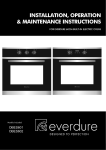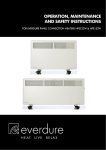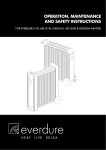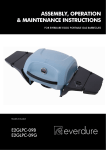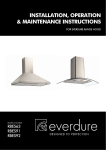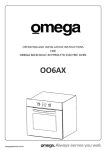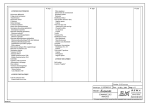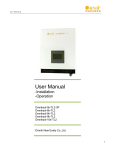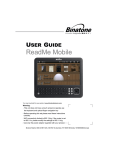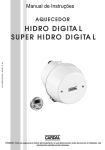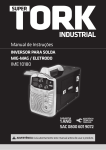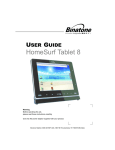Download INSTALLATION, OPERATION & MAINTENANCE INSTRUCTIONS
Transcript
INSTALLATION, OPERATION & MAINTENANCE INSTRUCTIONS FOR EVERDURE FREESTANDING ELECTRIC OVENS Models Included: UFEE61 INSTALLATION, OPERATION AND MAINTENANCE INSTRUCTIONS OBES61 FOR EVERDURE BUILT-IN ELECTRIC OVEN RANGE OBES61, OBES6 DESIGNED TO PERFECTION INSTALLATION, OPERATION AND MAINTENANCE INSTRUCTIONS FOR EVERDURE FREESTANDING ELECTRIC OVEN RANGE UFEE61 FREESTANDING ELECTRIC OVENS CONTENTS SECTION PAGE NO. Important Safety Instructions ………….. Appliance Details ………………………… Electrical Connections ………………..…. Installation ………………………………… Operating Instructions …………………… Cooking Guides ..….………………….…. Cleaning ………………………………….. Troubleshooting ………………………….. Transportation ……………………………. 3 4 5-6 7 8-12 13-15 16 17 17 CONGRATULATIONS Welcome to the Everdure Kitchen Community and thank you for choosing one of our many fantastic cooking appliances. We are confident that you will now be able to meet your cooking needs. Before you use the oven we strongly recommend that you read though the whole user manual which provides the description of this product and the proper use of its functions. To avoid the ever-present risks involved with using an electrical appliance it is vital that the oven is installed correctly and that you read the safety instructions carefully to avoid misuse and hazards. It is important that you retain these instructions and your proof of purchase along with any other important documents about this product for future reference. Due to continual product development, Everdure reserves the right to alter specifications or appearances without notice. Note: Some of the diagrams are generic & are for reference only. DESIGNED TO PERFECTION 2 IMPORTANT SAFETY INSTRUCTIONS IMPORTANT: Read the assembly instruction section and safety precautions of this booklet carefully before removing the contents of this carton. 1. 2. 3. 4. 5. 6. 7. 8. 9. 10. 11. 12. 13. 14. 15. 16. 17. 18. 19. 20. 21. 22. 23. 24. 25. 26. This appliance is not intended for use by persons (including children) with reduced physical, sensory or mental capabilities, or lack of experience or knowledge, unless they have been given supervision or instruction concerning the use of the appliance by a person responsible for their safety. Children should be supervised to ensure that they do not play with the appliance. After removing the packaging, make sure to check if there is any damage to the appliance. If there is any damage, never attempt to use the appliance and immediately contact your Authorized Service Centre. As packaging materials can be dangerous to children, they need to be collected immediately and put out of reach. In certain circumstances electrical appliances may be a danger hazard. Check the conformity of voltage and power settings, which are specified on the information sticker attached to the appliance and/or packaging, with the usage conditions available. Do not place heavy objects in or on these appliances, or use for storage, or let children play or swing from the doors. These appliances are designed for cooking food only. Always keep the upper lid open when using the hotplates, or while they are hot. This appliance is designed for domestic household use only and for the cooking of domestic food products. Use as a commercial appliance will void the warranty. It should not to be used in a marine environment or outdoors and must be fully built in. Do not use the appliances until fully installed. The ovens are supplied with a set of cables for single phase connection. This is a high powered appliance and is required to be installed by an authorised person. If a 3 phase installation is required, the installer must supply the cables as recommended in this manual. If the electrical supply cord is damaged, either when being installed or after installation, it must be replaced by the manufacturer or similarly qualified persons in order to prevent a hazard. The electrical connection must be accessible after installation. The appliance must be electrically isolated before any maintenance can be performed, which includes changing a lamp. Electrical connection must be made as per local wiring rules and regulations. Do not disconnect the appliance with wet hands or bare feet, and do not disconnect the power cord with extreme force. For ovens, the appliance needs sufficient air circulation while it is operating. Carefully read the part of this manual, where installation procedures are explained, and make sure the relevant conditions are satisfied. Ensure that the kitchen is well ventilated or mechanical ventilation is in use while cooking in this appliance. Do not store or use flammable materials or aerosols near the oven. Items made from aluminium, plastic or plastic film should also be kept away from the appliance, as they may fuse to the surface. Never line the oven bottom with aluminium foil, as the consequent accumulation of heat could compromise the cooking and even damage the enamel. WARNING - Ovens and cooktops will become hot during and directly after use. Do not touch any components during this time, as they may be hot and can cause burns. To avoid burns, children should be kept away. Use heat resistant cooking gloves whereever possible when moving food and cooking utensils in and out of the oven. Cleaning may only be commenced on the appliance once it has cooled down and turned off. Do not use a steam jet or any other high pressure cleaning equipment to clean the appliance. Wash all accessories in hot soapy water or in a dishwasher, wipe dry with a paper or cloth towel. If you use your oven for an extended period of time, condensation may form. Dry it using a soft dry cloth. When the appliance is not being used, the knobs and buttons must be kept in the ‘OFF’ position. Where this appliance is installed in a caravan, it shall NOT be used as a space heater. Do not modify this appliance. Do not use harsh abrasive cleaners or sharp metal scrapers to clean the oven door glass as they can scratch the surface, which may result in the glass shattering. Clean the glass door using warm damp cloth and dry it with a soft cloth. All cabinetry and materials used in the installation must be able to withstand a minimum temperature of 50°C above the ambient temperature of the room it is located in, whilst in use. Certain types of vinyl or laminate kitchen furniture are particularly prone to heat damage or discolouration at temperatures below the guidelines given above. Any damage caused by the appliance being installed without adhering to the temperature limits set out above will be the liability of the owner. The appliance must be installed and put in operation by an authorised technician under the conditions provided by the manufacturer in this manual. The manufacturer cannot be held responsible for any damage that might occur due to faulty installation. The values indicated in the cooking guide sections are values obtained in a laboratory environment according to relevant standards. These values may vary according to the usage and environmental conditions of the product. When you first run your oven, a certain smell will emanate from the insulation materials and the heater elements. For this reason, before using your oven, run it empty at maximum temperature for 45 minutes. At the same time, you need to ventilate the environment in which the oven is installed. Do not leave the cooker while cooking with solid or liquid oils. There may be flaming up on conditions of extreme heating. Never pour water onto the flames occurring from oil. Immediately turn the cooker off and cover the saucepan or fry pan with a lid or fire blanket in order to smother the flame. Do not leave anything on the door when they are open. You may unbalance the product or break the griller door. Do not allow children to play, swing or sit on the doors. DESIGNED TO PERFECTION 3 APPLIANCE DETAILS ELECTRICAL DETAILS UFEE61: Rated Voltage: 220 to 240 Vac 50 Hz Max Rated Inputs: 8200W This information can be found on the rating plate (data label) affixed to the rear of the appliance. HOTPLATE RATING 145mm plate x 2 1000W each 180mm plate x 2 1500W each OVEN RATING Top element 1200W Bottom element 1100W Grilling element 2000W SIZES: Relevant Sizes: DEPTH (mm) External Oven size 600 4 WIDTH (mm) 600 HEIGHT (mm) 900 DESIGNED TO PERFECTION ELECTRICAL CONNECTIONS LOCAL AUTHORITY REQUIREMENTS Installation is only permitted by an authorized person, and carried out according to instructions provided by the manufacturer. Incorrect installation might cause harm and damage which the manufacturer accepts no responsibility. ELECTRICAL INSTALLATION Before carrying out the connection to the power supply, the voltage rating of the appliance (stamped on the appliance identification plate) must be checked for correspondence to the available mains supply voltage, and the mains electric wiring should be capable of handling the oven’s power rating (also indicated on the identification plate). NOTE: For connections to the mains power supply, never use adapters, reductions or multiple power points as these may overheat and catch fire. A circuit breaker with a contact opening of at least 3 mm must be installed inside the supply circuit. After having installed the appliance, the switched outlet must always be in an accessible position. The electrical safety of this appliance can only be guaranteed if the cooker is correctly and efficiently earthed. The manufacturer declines all responsibility for damage resulting from a system which has not been earthed. WARNING: It is essential to use specific soft wire or specific groupware bought from the manufacturer or maintenance department to replace if the electrical soft wire has been broken. IMPORTANT: The following figure shows the connection details and minimum diameters of supply cables that must be used for both single and three phase connections: WARNING: For single phase connection, three shortcut circuit bridges must be installed as seen in the above picture. If shortcut circuit bridges are not installed properly, some cooking zones do not operate. These ovens must be connected to a 220-240V 50Hz power supply. They are earthed via the supply cord. The earthing cable must be connected via the screw with the earthing mark. The switched outlet must be connected to a suitable earth wiring, in conformity to current safety regulations. The cooking appliance must be connected to a switched outlet. It should not be located above the appliance and no more than 1.25m away from it. The power supply cord must not touch against any hot surfaces and must be placed so that its temperature does not exceed 75 °C at any point along its length. The mains terminal block is located at the rear of the oven and the terminals are accessible by removing the terminal block cover. If the mains supply cable is damaged during or after installation, it must be replaced by a licensed electrician with a cable supplied by the Authorised Service Centre. DESIGNED TO PERFECTION 5 For appliances intended for use in New Zealand: If this appliance is to be connected to a new or upgraded electrical installation, then it must be connected to the supply by a supply cord fitted with either: a) an appropriately rated plug that is compatible with the socket outlet fitted to the final sub-circuit in the fixed wiring that supplies this appliance; or b) an appropriately rated installation male connector that is compatible with the installation female connector fitted to the final sub-circuit in the fixed wiring that supplies this appliance. The size of the supply cable that is to be used is one that has a H05VV-F rating and of sufficient current carrying capacity for the cooking range loading of 8200W. OVEN LAMP REPLACEMENT The appliance must first be disconnected from the power outlet or turned off at your isolation switch. Unscrew the glass cover attached to the lamp holder; anti-clockwise. Unscrew the lamp and replace it with another high-temperature lamp with the following characteristics: Type: E14 Voltage: AC220V-240V Wattage: 25W Temperature rating: 300°C Remount the glass cover and reconnect the appliance to the power outlet or turn on at your isolation switch. NOTE: Should you experience any difficulty please contact your nearest Authorised Service Centre. 6 DESIGNED TO PERFECTION INSTALLATION The adjacent furniture must be able to withstand a minimum temperature rise of 50°C above the ambient temperature of the room it is located in, during periods of use. The power supply to the appliance must be switched off before any adjustments or maintenance work is done on it. PREPARATION FOR INSTALLATION AND USE Manufactured with best quality parts and materials, this modern, functional and practical oven with cooktop will meet your needs in all respects. Make sure to read the manual to obtain successful results so as not to experience any problems in the future. The information given below contains rules that are necessary for correct positioning and service operations. They should be read without fail, especially by the technician who will position the appliance. INSTALLATION OF COOKER The cooker can be placed close to other furniture on condition that in the area where the cooker is set up, the furniture’s height does not exceed the height of the cooker. Do not place the cooker near a refrigerator. When choosing a place for the cooker, attention should be paid that there are no flammable or combustible materials in the close vicinity, such as curtains, oil, cloth etc. which quickly catch fire. There must be at least a 2 cm clear space between the back cover of cooker and any wall for air circulation. Furniture surrounding the cooker must be made of materials resistant to temperatures 50 C° above the ambient temperature or more. The cooker is designed to fit between kitchen cabinets spaced over 500 mm apart. The space either side of the cooker needs only be sufficient to allow withdrawal of the cooker for servicing. It can be used with cabinets on one side or both sides as well as in a corner setting. It can also be used freestanding. The minimum from the hotplates to an overhead fan or range hood is 650mm, and to overhead cupboards is a minimum of 700mm. ADJUSTMENT OF LEVELING LEGS The oven must be installed directly on the floor & not on a base. The cooking appliance stands on 4 levelling legs. The appliance must be levelled before operating it. This adjustment can be made by turning the levelling legs clockwise, if required. It is possible to raise the product a maximum of 35 mm via the levelling legs. Once the levelling legs are adjusted appropriately, do not move the product by dragging it as this may damage the legs. The levelling legs can be adjusted by hand or with a large metal coin (such as a 50c coin). ANTI-TILT KIT The document bag contains an anti-tilting kit. Anti-tilting bracket (1) should be removed from the kit and installed onto the wall (128mm in from where each side of the oven will be). The adaptor (2) that will provide connection of the anti-tilting bracket to the oven is preinstalled to the oven with 4 screws already attached. The height can be adjusted by loosening the 4 screws of the adaptor (max height of 242mm). The oven is leaned backwards on an angle so that the anti-tilting bracket fits into the adaptor and then pushed forwards to lock them in. DESIGNED TO PERFECTION 7 OPERATING INSTRUCTIONS Cooktop Control panel Oven Door Handle Drawer Cover 5. Leg 6. Oven Door 7. Oven Tray 8. Wire Grid 9. Oven Seal 10. Oven Lamp 11. Hotplate 1. 2. 3. 4. Mechanical Timer Knob 8 Function Oven Temperature Control Knob Control Knob Hotplate Control Knobs DESIGNED TO PERFECTION When you first run your oven a certain smell will be emanated arising from the insulation materials and the heater elements. For this reason, before using your oven, run it empty at maximum temperature for 45 minutes. At the same time you need to properly ventilate the kitchen or environment in which the oven is installed. In order to cook in your oven, the oven function and temperature setting control knob needs to be adjusted. The oven timer needs to be programmed either on “M” for manual, or a set period of time between 0-100 minutes, otherwise the bottom oven will not operate. Turn your appliance off when it is not in use. Protect your appliance from atmospheric effects. Do not leave it under the effects of the sun, rain, snow, dust etc. USING THE COOKTOP HOT PLATES The cooktop part of the appliance is controlled via a knob on the control panel (with 7 heat levels). Position “0” is the off position. The remaining 6 positions indicate the following types of use: 1 : Heat maintenance position. 2-3 : Heating in low temperature position. 4-5-6 : Cooking, frying and boiling position. The knob rotation direction may differ according to the product specification. Surfaces of hotplates are covered by a protective layer. At first use, operate the hotplates without a pan at heat position 3 for 5 minutes in order to safely remove this layer and any residual smell. Pans with flat base are highly recommended. Also, the size of the pans must be in line with the size of cooktop hotplate elements for most efficient usage. Always centre the pans on the hotplate elements. Using small sized pans on the large sized heating elements will cause heat loss and so energy will be wasted. WARNING: Using cookware that is too large can cause discolouration or damage to the cooktop surface around the heat zones, which is NOT covered under warranty. After using any hotplate element, please make sure that it is switched off. Never touch any hotplate element, after it is turned off as it retains the heat for a certain period of time. Do not let children come too close while the cooktop is hot or in operation. Clean the hotplates and enamel surface around the hotplates with a warm, damp, wet cloth after use, but ensure the hotplates are off and not too hot. If there is excessive spillage, you can clean the hotplates with a warm, damp, slightly soapy cloth (e.g. dishcloth). If you do not intend to use the hotplates for a while, apply a thin layer of machine oil onto each hotplate element for an extended life. DESIGNED TO PERFECTION 9 OVEN FUNCTION CHART USING THE OVEN The knob on the left hand side allows you to select the oven functions. Detailed information on their usage is explained in the following pages. The next knob to the right allows you to select the temperature of the oven, and the next knob to that allows you to set a timer. Note: The red indicators are on only when an element is running. Once the element has reached the correct temperature, the indicator will turn off. USING THE MECHANICAL TIMER The mechanical timer only controls the main oven. Manual Operation When you set the timer knob by turning it anti-clockwise to the “M” position as seen in the illustration, the oven function can be operated continuously. The oven cannot be operated when the timer knob is in “0” position. Operation with Time Set Turn the timer knob in clockwise direction in order to set time between 0-100 minutes as seen in figure to the left. When the adjusted time ends, the oven is turned off and a single audible warning sound is heard. 10 DESIGNED TO PERFECTION Convection Function This function allows heat to radiate evenly from the lower and upper elements into the oven ensuring even cooking of both sides of the food. Adjust the function control knob so it indicates the Convection Cooking function symbol. Continue to turn the knob of your oven to a temperature recommended on the cooking table (below) for the cooking operation you wish to perform. Preheating of the oven for about 10 minutes is recommended. Place food in a suitable container, then place into oven and cook for the recommended time. This function is preferred for making cakes (cupcakes, other cakes and sponges), biscuits, pastry, baked pasta (e.g.: lasagne), casseroles and moist dishes, roasts and oven chips. After cooking, turn off the oven function control. Take the cooked food out of the oven and place it on a safe heatproof surface. As the oven will be hot, work near with caution and keep children away from the cooling oven. Lower Heat Function On this function the lower heating element will come on. This function is recommended for finishing off the cooking of food (in baking dishes or trays) which is already superficially well-cooked and golden on the top but still soft inside. Adjust the function control knob so it indicates the Lower Heating function symbol. Preheating of the oven for about 10 minutes is recommended. Place food in a suitable container, then place into oven and cook for the recommended time. This is an ideal function for delicate cooking such as quiches, cheesecakes and custards were limited top browning of the food is required. After cooking, turn off the oven function control. Take the cooked food out of the oven and place it on a safe heatproof surface. As the oven will be hot, work near with caution and keep children away from the cooling oven Mid-Grill Function This function is used for grilling. Adjust the function control knob so it indicates the Mid-Grill Function symbol. After a preheating period of 10 minutes, put your food into the oven. For grills, put the food on the grill rack and sit into the tray. Place the tray on one of the upper shelves. Placing the rack within the oven tray provided will ensure that any marinade, fat or oil dropping from the food will be collected. On this function the middle heating coils of the grill will operate. This setting is ideal for toasting bread, cheese melts and melting cheese topped dishes and finishing off a dish to lightly brown on the surface. Also used for herb and garlic bread. After cooking, turn off the grill function knob. Take the cooked food out of the oven and place it on a safe heatproof surface. As the grill will be hot, work near with caution and keep children away from the cooling oven. Use this function with the thermostat set at 190°C & the oven door closed. You will experience the pilot light and heating element turn on and off periodically in order to maintain the temperature at 190°C. Maxi-Grill Function This function is used for faster grilling and for grills with a lot of food. Adjust the function control knob so it indicates the Maxi-Grill Function symbol. After a preheating period of 10 minutes (ideally include the tray and grill rack in the preheat when cooking meat, fish or poultry), place your food into the oven by placing onto the grill rack, which is sitting in the tray. Placing the rack within the oven tray provided will ensure that any marinade, fat or oil dropping from the food will be collected. Place the tray on one of the upper shelves. On this function the middle and outside heating elements/coils of the grill are activated (Note- the outside element does not always radiate a red glow whilst in operation). The higher grill temperature and function is ideal for cooking and browning meat (such as lamb or pork chops and cutlets), chicken and seafood (such as fish fillets, cutlets, tuna steaks or Atlantic salmon). This setting is also good for browning fruit crumbles or crumb topped dishes although the wire rack will need to be moved to shelf position 3. After cooking, turn off the grill function knob. Take the cooked food out of the oven and place it on a safe heatproof surface. As the grill will be hot, work near with caution and keep children away from the cooling oven. Use this function with the thermostat set at 190°C & the oven door closed. You will experience the pilot light and heating element turn on and off periodically in order to maintain the temperature at 190°C. DESIGNED TO PERFECTION 11 ACCESSORIES USED IN OVEN It is recommended that you use the containers indicated depending on the food you will cook in your oven. You can also use glass containers, cake pans and special oven trays suitable for use in your oven (available in kitchenware shops). Pay attention to the information given by the supplier for use of this cookware. The information given below should be implemented for enamelled containers. If the food to be cooked does not completely cover the oven tray, if the food is taken out of the deep-freezer or if the tray is used to collect the dripping juices of the foods during the grill operation, deformation might be observed on the tray over time due to high temperatures forming during the cooking/baking operation. This is a normal, physical state that results during the heat transfer. Do not leave a glass tray or container in a cold environment immediately after cooking in them. Do not place them on cold and wet surfaces. Ensure that they slowly cool off by placing them on a dry piece of cloth or wooden board, otherwise, the glass tray or container might break. If you are going to use your oven to grill, we recommend using the grill rack on the tray, supplied together with your product. This way, splattering and dripping oils will not make the oven interior dirty. If you are going to use the large wire oven rack/grill, insert a tray into one of the lower racks to collect fat or oil. To make cleaning easier, add some water into this tray. In a grilling operation, use the shelf in position 5 or 6. 12 DESIGNED TO PERFECTION COOKING GUIDES LOWER‐UPPER HEAT– (Convection) FOOD Thermostat pos. (°c) Rack pos. Cooking Period (min) Roast Pork Roast Chicken Roast Beef ‐ rare Roast Beef ‐ medium Roast Beef ‐ well done Roast Lamb ‐ medium Roast Lamb ‐ well done Roast Turkey Roast Duck Roast Veal – well done Baked whole fish Casserole/ moist dishes 230 + 190 190 ‐ 200 190‐200 190‐200 190‐200 190‐200 2‐3 2‐3 2‐3 2‐3 2‐3 2‐3 20 + 45/50 min per kilo 50‐60 min per kilo 15‐20 mins per 500g 25 mins per 500g 30 mins per 500g 20 mins per 500g 190‐200 180 180‐200 2‐3 2‐3 2‐3 30 mins per 500g 40‐45 mins per kilo 30‐35 mins per 500g 180 180 2‐3 2‐3 30 mins per 500g 15‐20 min per kilo 180 2‐3 Roast Pumpkin 220 2‐3 60‐80 mins 20‐40 mins depends on size of pieces Scones Plain or fruit Cake ‐ Butter cake (deep) Cake ‐ Sponge Cake – Cup cakes Cookies – Choc chip Biscuits ‐ Anzac Brownie Banana Loaf Pavlova Meringues ‐ Hard Pastry (pre‐rolled frozen) Pastry ‐ Savoury homemade Pastry –Sweet homemade Pizza ‐ home made Chips ‐ Oven baked 220 2‐3 10‐15 180 180 180 180 180 180 180 110 110 2‐3 2‐3 2‐3 2‐3 2‐3 2‐3 2‐3 2‐3 2‐3 40 25‐30 10‐15 15‐20 15‐20 30‐40 40‐50 90 90 190‐200 2‐3 20‐30 180‐200 2‐3 20‐30 180‐190 250 or max 200 2‐3 1 2‐3 20‐30 10‐15 30‐40 For optimum cooking keep edges of baking dishes and pans at least 4cm from the sides of the oven. This allows free heat circulation and ensures even cooking. Where possible remove large cuts of meat 1kg or over from the fridge 1 hour prior to cooking. Allow, to stand covered and away from direct sun/heat. This process will take the “chill” of the fridge away from the food and assist in more even cooking. DESIGNED TO PERFECTION 13 Oven Shelf Location Your Everdure oven has six positions or racks for the oven shelves to be positioned depending on your choice of cooking function and size of roasting dishes or containers. These are numbered from 1 (the lowest shelf position) to 6 (the highest shelf position). See diagram in previous section of this manual. To obtain maximum space above and below the shelves, it is recommended that you position trays and dishes in the following way: When using only 1 shelf, use position/rack 2 or 3. When using 2 shelves, use position/rack 2 and 4. Cooking Pizza For the best results when cooking pizza use the Lower and Upper Heat Element function (Convection) and the lowest oven shelf position. A temperature of 250°C or max can be used, but take care & watch the pizza so it does not burn. Preheat the oven for at least 10 minutes. Use a non-stick pizza pan, ideally one with holes in the base specifically for pizza cooking. Do not open the oven door frequently while the pizza is cooking. If the pizza has a lot of toppings (three of four), it is recommended that the mozzarella cheese be placed on top halfway through the cooking process. Remember the best pizzas are made with a less is best method when choosing the topping ingredients. Check the base is crispy by lifting the pizza pan from the oven with a heatproof glove and lifting the pizza with an oven slide to look at the pizza base. Return to oven if further cooking is required. Roasting Meat, Cooking Chicken and Fish Ideally, meat should be at least 1Kg or more when roasting in order to prevent it from drying out. When cooking white meat, poultry and fish, use temperature settings (180°C-220°C). For red meat that should be well done on the outside while tender and juicy on the inside, it is a good idea to start with a high temperature setting (200°C-220°C) for a short time, then turn the oven down afterwards and finish off. When larger cuts of meat, poultry or fish have finished cooking, ideally remove the food from the oven and cover with foil and stand for 10-20 minutes (depending on size). This will help retain the juices when the meat is carved. When cooking large whole fish 1kg or larger it is recommended that the flesh be scored or slashed 23 times on either side to assist in more even cooking. To do this cut into the thick fish flesh behind the head through to the bone. These scored areas also allow you to check easily to see if the fish is cooked. It is a good idea to either measure the inside of your oven for width and either write this down in a book you may have with you when shopping or you can cut a piece of string the oven width. This makes it easier to know if your fish will fit into the oven. Looks can be deceiving and the fish looks so much better whole with its head and tail. If it doesn’t fit you will probably need to remove the head prior to baking. Grilling Cooking times may vary according to the nature of the foods, their homogeneity and their volume. When cooking a certain food for the first time, it is advisable to choose the lowest temperature and then increase temperature as required. When using the griller function in the oven – adjust the shelf position as required for the best results. As a guide the grill functions have an average temperature of 200C. 14 DESIGNED TO PERFECTION Cakes and Baking Organize the oven shelves while the oven is cold and before preparing a recipe. When baking follow the directions in the recipe however if in doubt, as a general rule, the food (e.g. cake) is positioned on a shelf that will have the top of the cake surface as near to the centre of the oven as possible. Preheat oven before preparing the cake or baked items as some baked food should not sit waiting for the oven to reach the required temperature. For best results the baked food should go straight into the preheated oven at the correct temperature. Use kitchen baking paper to line cake tins and baking trays for cookies and roast vegetables such as pumpkin. When making cakes have eggs at room temperature. When making sponge cakes don’t tap the beaters on the side of the bowl when the beating is complete as this will knock out precious air you have just spent time adding. Remove the beaters from the hand mixer and tap them over the edge of your open palm to knock any remaining cake mix into the bowl below. Pavlova and Meringues Eggs should be at room temperature. Ensure that the bowl and beaters to be used are super clean and have no grease, oil or fat on them as this will retard the beating and peak forming process. It is a good idea to crack the eggs to be used one at a time over a small bowl to separate the egg yolks and whites. That way if a yolk does break it will not end up in your main bowl of egg whites. When making pavlova or meringues don’t tap the beaters on the side of the bowl when the beating is complete as this will knock out precious air you have just spent time adding. Remove the beaters from the hand mixer and tap them over the edge of your open palm to knock any remaining mix into the bowl below. Line baking trays with kitchen baking paper. When they are cooked, remove the tray from the oven and use a very flat spatula to loosen the food from the baking paper. Return the Pavlova or meringues to the oven and allow to stand overnight or until the oven is cold for best results. Think about using the remaining egg yolks to make homemade mayonnaise. DESIGNED TO PERFECTION 15 CLEANING NOTE: Cleaning and maintenance operations must only be carried out when the oven and cooktop are cool. The appliance should be isolated from your mains supply before commencing any cleaning process. Before starting to clean your oven or cooktop, be sure that all control buttons are off and your appliance is cooled off. Do not use cleaning materials containing particles that might scratch the enamelled and painted parts of your oven. Use cream cleaners or liquid cleaners, which do not contain particles. As these cleaners may damage the surfaces, do not use caustic creams, abrasive cleaning powders, rough wire wool or hard tools. Before using the cleaning materials check whether they are appropriate and recommended for use by the manufacturer on your oven. In the event of any excess liquids spilling over your oven surface during cleaning, clean up immediately so as to prevent possible damage to the enamel or metal surface. Do not use steam cleaners for cleaning the oven. CLEANING THE OVEN You will obtain best results if you clean the oven interior while the oven is slightly warm. Wipe the oven with a soft cloth that had been dampened in soapy water after each use, then wipe it with a wet cloth once more and then dry it. It may be required to use a liquid cleaning material from time to time and completely clean the oven. Do not clean with dry and powder cleansers. CLEANING THE COOKTOP Any residues that are left on the cooktop surface from cleaning agents may damage it. You should remove any residues with water and a little washing up. Abrasive cleaners or sharp objects will damage the cooktop surface. The cooktop should be cleaned using water and a little washing up liquid. Although it is easier to clean some deposits whilst the cooktop surface is still warm, you should take extra care not to burn yourself. It is recommended to only clean the cooktop when cold. AFTER EACH USE Wipe the appliance over with a damp cloth and a little washing up liquid. Dry the appliance by rubbing the surface with a clean cloth. For non-stainless steel cooktop surfaces, a mild, non abrasive cream cleaner may only be used. MAINTAINING THE SOLID PLATES If something is spilt onto the plate itself, then it can be removed using a soft brush, plastic or nylon scourers and warm water. To keep the solid plates in good condition, you should put a little olive oil onto a kitchen towel and rub it onto the surface of the plate. The next time the plate is used, it may produce a little smoke. Alternatively you can use a hotplate cleaner; these products can normally be found at larger supermarkets and hardware stores. The cleaning agent instructions should be followed when using these products. IMPORTANT: If the solid plates are not maintained regularly with olive oil or a hotplate cleaner, then they may rust. 16 DESIGNED TO PERFECTION TROUBLESHOOTING If the oven does not operate: The oven may be off at your switched outlet. The timer may not be set to the manual function or have the timer set to function. If the interior lighting lamp does not light: The lamp may be defective. If defective, you can change it following the instructions within this manual. Cooking (if lower or upper part does not cook equally): Control the shelf locations, cooking period and heat values according to the manual. Unit smoking when first used: This is a result of protective oils being removed and is to be expected with a first use. Condensation build-up on the oven door: Clean off with dry soft cloth. If you still have any problems with your product, please call your Authorised Service Centre. TRANSPORTATION Keep the original carton of the product and use these if the item needs to be transported. Follow the transport signs on the carton. Tape cardboard or paper onto the inside face of the glass as it will be prone to damage from the trays. Use cardboard covers for the wire grill and trays in your oven. Also tape the oven’s covers to the side walls. If the original carton is unavailable, take measures to protect the external surfaces (glass and painted surfaces) of oven against possible blows, as well as the above. DESIGNED TO PERFECTION 17 18 DESIGNED TO PERFECTION DESIGNED TO PERFECTION 19 A division of Shriro Australia Pty Ltd 23-27 Chaplin Drive Lane Cove NSW 2066 AUSTRALIA: 1300 355 541 NEW ZEALAND: (09) 415 6000 www.everdure.com IM Ref: UFEE61 30/2012/01FC FOR INDOOR USE ONLY DESIGNED TO PERFECTION




















